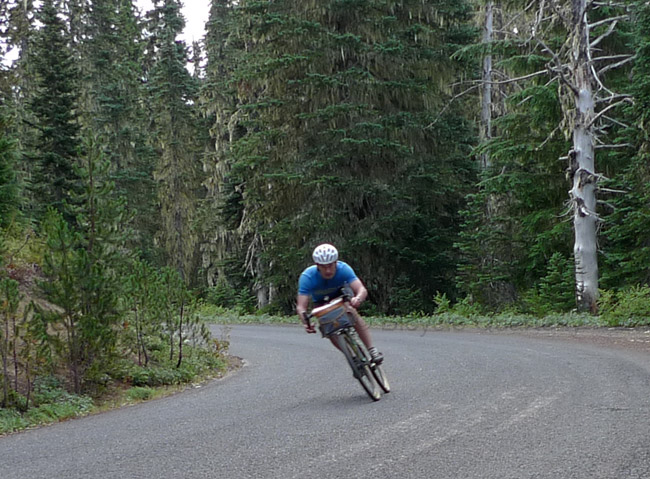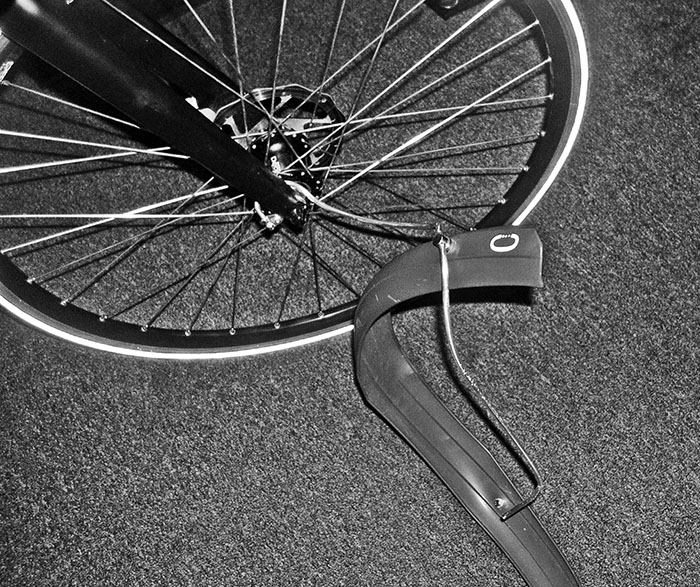Putting Our Lives on the Line

Testing bicycles may sound like a dream job – you get to ride all kinds of bicycles without having to pay for them – but it comes with risks. We ride the bikes hard, although we don’t abuse them. We are smooth riders, so we don’t stress components unduly. Even when riding the bikes as intended, problems often manifest themselves during our two-week test. We’ve tested more than 60 bikes, and there have been a number of close calls and actual injuries.
On one test bike, the headlight fell off and hung from its wire, dangling in the spokes. On another, a poorly mounted front fender broke loose and wrapped itself around the front wheel during a high-speed descent on a busy road (below). I was lucky not to crash, but a friend of a friend suffered a similar failure on a bike from the same maker and is still dealing with a the consequences of a brain injury.

I’ve broken my thumb when the tires of a test bike offered next to no grip in the wet, and I crashed as I braked for the first corner. Two handlebar bags have flown off the front rack from decaleurs that were too loose or broke off entirely. I rode over one, the other one went sideways. A year ago, I approached a stoplight at the bottom of a steep hill when the straddle cable pulled out of the front cantilever brake, leaving me with only the rear brake and almost no brake power. That certainly was exciting!
I’ve had other close calls. A just-introduced hydraulic disc brake was recalled two weeks after our test. The seals could blow out in cold temperatures, “resulting in abrupt loss of brake power, and an inability to stop the bike,” according to the manufacturer. And I just had taken the bike with those brakes on steep mountain descents and braked so hard that I could feel the left fork blade flex and affect the bike’s steering. Good thing it wasn’t very cold during my night-time descents on the bike.
A carbon fork I had been testing was recalled the next month, because several of them had broken after just a few months of riding. On another bike, a tire was mounted incorrectly with a large wobble. On yet another, a front brake pad came loose. Fortunately, I noticed it before it fell off completely.
Why write about these incidents? There is no glory in road rash or broken bones. I write about them because all these problems were avoidable, and we don’t want the same things to happen to you. The problems were due to poor design, careless manufacture or faulty installation. On our own bikes, these incidents simply don’t happen. We choose parts that have proven themselves over many years of riding. We are careful to assemble our bikes well. If something breaks, it’s usually after many years of hard use.
If you are fastidious, you’ll completely strip down any bike you buy and re-assemble it correctly before you ride it. Car racers do that when they buy a race car… For most people, this isn’t practical, but here are five safety checks that can eliminate some of the biggest risk factors:
- Brakes: Pull on the lever for the front brake as hard as you can. The brake pads should squish, the brake may flex, but the cable should not pull out of its anchor on the brake. I’ve done this test on three new bikes recently, and on two, the cable pulled out of the brake. On these bikes, the brakes work fine until you really need them in an emergency situation!
- Check that both tires are seated correctly. Most tires have a line molded into the sidewall that should sit just above the edge of the rim. That line must be concentric with the rim. If it dives under the rim edge, the tire isn’t seated correctly and could blow off while you ride.
- Push down sharply on the brake levers (with drop bars) or the ends of the handlebars (with swept-back bars). The bars should not rotate in the stem.
- If your bike has a decaleur, insert the bag and remove it. Is it tight enough to stay put when you go over big bumps? If it isn’t, use additional straps to secure the bag on the rack platform.
- Problems with wheel quick releases have been publicized so much that they hopefully are rare. Even so, check that they are closed tightly.
Assembly problems are usually easy to correct or mitigate. More difficult is dealing with issues of poor design. Often, the only solution there is to walk away. There are also some things that I prefer not to test, because they are simply too dangerous:
- Inexpensive carbon forks. There are just too many cases of them breaking.
- Bikes that have anything clamped to a tapering fork blade. It’s bound to come loose.
- Fenders that are poorly mounted or have inadequate clearances.
- Sorry to say, but anything sold by Civia. Too many recalls, and too poorly designed are their bikes. (Both the fender incidents described in the post were on Civias – with two different fender designs – as well as the fork recall.)
Cycling is not a particularly dangerous sport, but like any activity, taking sensible precautions greatly reduces your risk. I wish companies would take more care when they design their bikes and components – they are playing with our lives!
At Bicycle Quarterly, we will keep pushing bike builders and manufacturers to make their bikes safer. As avid riders, our own health and safety depends on it.
Do you have any additional tests you use to reduce the risk on a newly-assembled bike?


